Genre: Shmup Developer: Toaplan Publisher: Seismic Players: 1 Released: 1990
One genre I think is really overlooked on the Genesis is shooters. Everyone always mentions the Thunder Force games, or the poor translation of Zero Wing, but few people mention that the Genesis stomped the Super NES when it came to the selection of shooters. The only system at the time that could compare when it came to the shooter genre was the Turbografx-16, but the Genesis quickly moved to be THE system for shooters within the first two years of its life span. Many of the shooters had a unique element that made each one stand out. A lot of shooters went unnoticed in this era, just because there were so many to choose from. If you didn’t have a unique feature in your game, it simply fell to the background amongst more innovative titles.
Hellfire is one of those titles. It was first released as an arcade game in 1989 and was ported to the Genesis/Mega Drive in 1990. This is a side scrolling shooter where you pilot a ship called the “CNCS1.” The background story involves mankind being at a point where our species is exploring the galaxy and colonizing other worlds. However, a nebula appears that begins to devour whole systems, and begins to approach mankind’s newest territory. You find out that something called Super Mech is controlling the nebula, and like many shooters of the time, mankind pours all of its eggs into one fighter spacecraft to save the universe. The game gets its name from the spacecrafts super weapon, which is called the Hellfire. Trust me, this weapon is well named, but we’ll get to that in a minute.
The unique feature of this game is the ability to change the angles your ship fires by pressing the B button. You can cycle through four different modes, and each mode re-colors the ship sprite so you know what mode you are in not only by looking at the firing direction, but just the ship itself. Pink fires straight forward, yellow fires straight backward, green fires two beams up and down, and blue fires a four-way diagonal beam. The faster you learn the order of cycling through the colors, the more efficient you’ll be in this game, as often enemies can be behind cover, and only a single mode can hit it.
Additionally, there are also power ups that can give your ship shielding and increase the power of your shot. The C button activates the Hellfire, a powerful laser much larger than your normal shot that rips through standard foes in impressive manner. You can only fire a couple of these when you start though, so only use it when you need it! I also recommend before you play go in the options menu to turn on auto-fire. It makes the game a lot easier than hammering on the A button constantly to fire, and with this game you may need all the help you can get in the later stages. It was pretty cool to see this feature in the options menu, as most companies used the “hammer on the button” technique to force people to pick up a turbo controller for shooters so they wouldn’t wear out either their controllers or their thumbs.
The graphics are nice for an early Genesis title. Sprites are nice and sharp, and there’s a decent level of detail for an early title. However, the graphics do pale in comparison to some other shooters such as M.U.S.H.A., however they are quite serviceable and look nice for the era the game was released in. I’d say the graphical quality is a bit above Zero Wing. The music suits the game, however there’s no real standout tunes you’ll find yourself humming after you play. The tunes are rather atmospheric and fitting to the particular level you are playing, but this isn’t a game with music you’ll be humming with after you are finished playing.
The levels are pretty interesting and give you a good mix of settings in space/technologically based, as well as organic levels such as caves with wild looking plant life. The enemies aren’t quite as nice looking, just your standard mechanical bots and ships for the most part. Bosses are large sprites, also mechanical looking for the most part, and like many other shooters are invincible other than a weak spot you must aim for to shoot them down. That’s where the ability to alter your firing angle comes in extremely handy, dodging enemy attacks while scrolling through your firing modes to find the best angle to hit a boss’s weak area while staying clear of his attacks on you.
If you are new to shooters, you might be in for a world of hurt. The game starts out easy enough but soon the bullets begin to fill the screen. You’ll have to have quick reactions not only to dodge the bullets but also to cycle through your weaponry quick enough to find the proper firing angle for the legions of enemies you’ll be facing. Memorizing the order of your angle of firing switches is very important to your survival. However, a lot of the projectiles are rather slow-moving, but sheer numbers make up for the difference in the speed. When you get killed, you know it was your own fault and now the game just being cheap. It’s a great incentive to keep you plowing forward and gives that game that charming “one more time” element that keeps you playing.
Hellfire also had a pseudo sequel/upgrade over in Japan on the PC-Engine. A CD version of the game was released known as Hellfire S: The Another Story. This game featured similar gameplay to the arcade and Genesis versions of Hellfire, but also added in an animated opening and ending, as well as higher quality music and slightly touched up graphics. Everything else remains the same though, including the gameplay.
So far you shooter fans out there, give this one a try. It’s a fun game with a unique gimmick that I haven’t seen before. If, however, you aren’t a fan of shooters, there’s not enough new here to attract you to the genre. For some reason, you don’t see this game mentioned with the rest of the great Genesis shooters, such as Gaiares, Sagaia, or M.U.S.H.A., but it should be up there with the best shooters, if you are a fan of the genre.
SCORE: 7 out of 10

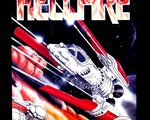
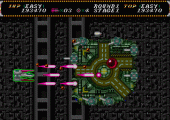
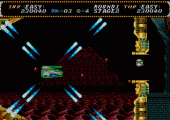
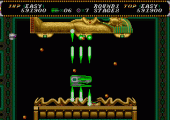
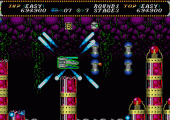
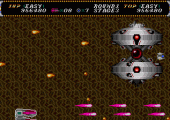
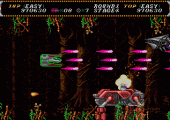
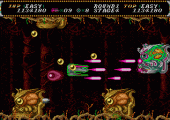
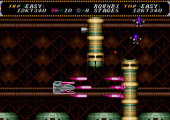
I think this is one of the most brilliant side-shooters ever made. The split-second decisions you make with the weapon-system creates those special tense game-moments, in which the player comes out like a genius or a complete failure. At the same time your learning the game and a strategic approach is also forming. By the way: has any one ever finished this game ?
Nice detailed review of a great and underappreciated game. The only thing I disagree with is your assessment that the music is nothing special. I would suggest that the soundtrack is very good. At the very least Stages 1,3 and 4 have great tunes which really fuel you through the game. Stage 2 is not bad either. The music is pretty unique, being slightly offbeat and it really sounds like it was composed and meant for the fm synth. I think out of 6 stages that is a far better ratio than most games!